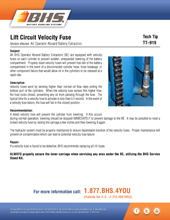We use cookies to make your experience better. To comply with the new e-Privacy directive, we need to ask for your consent to set the cookies. Learn more.
TT-919: Lift Circuit Velocity Fuse
Models Affected: All Operator Aboard Battery Extractors
All BHS Operator Aboard Battery Extractors (BE) are equipped with velocity fuses on each cylinder to prevent sudden, unexpected lowering of the battery compartment. Properly sized velocity fuses will prevent free-fall of the battery compartment in the event of a disconnected cylinder hose, hose breakage, or other component failure that would allow oil in the cylinders to be released at a rapid rate.
Description:
Velocity fuses work by sensing higher than normal oil flow rates exiting the bottom port of the cylinders. When the velocity fuse senses this higher flow, the fuse locks closed, preventing any oil from passing through the fuse. The typical time for a velocity fuse to activate is less than 0.5 second. In the event of a velocity fuse failure, the fuse will fail in the closed position.
Recommendation:
A failed velocity fuse will prevent the cylinder from lowering. If this occurs during normal operation, lowering should be stopped IMMEDIATELY to prevent damage to the BE. It may be possible to reset a locked velocity fuse by raising the carriage a few inches and then lowering it again.
The hydraulic system must be properly maintained to ensure dependable function of the velocity fuses. Proper maintenance will prevent oil contamination which can lead to potential velocity fuse failure.
Repair:
If a velocity fuse is found to be defective, BHS recommends replacing all (4) fuses.
ALWAYS properly secure the inner carriage when servicing any area under the BE, utilizing the BHS Service Stand Kit.


